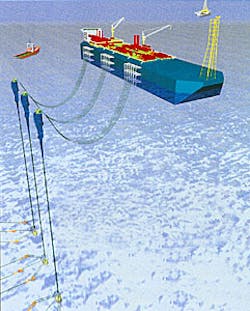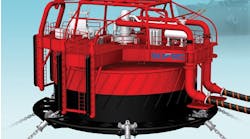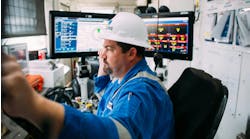Girassol team solves insulation problem, horizontal well control less certain
Artist's impression of the Girassol FPSO and compliant riser towers, which will be installed in 1,350 meters of water. [4,166 bytes]
- Cross-section of the riser tower with 8-in. multipurpose risers and service lines/gas lift risers.
- Planned Girassol subsea well locations. [19,091 bytes]
- Riser tower base, showing sea lines and wet insulated bundles. [4,855 bytes]
- One of the Girassol well trajectories considered during swab kick tolerance calculations. [6,618 bytes]
- Well type B2 [13,867 bytes]
The contractor team insisted that the adjustments discussed were within the normal range for projects this size. But if topsides fabrication is to be switched from Fos in France to the Far East - bearing in mind that this is one of the world's largest floaters - a 2000 production start looks somewhat tight.
However, even if a cut-price yard does gain this honor, the basic composition of the engineering team for Girassol will remain heavily French. Key duties are split between the Mar Profundo duo responsible for the FPSO - Bouygues Offshore and ETPM, with detailed engineering support from Technip-Geoproduction - and the Alto Mar umbilicals/flowlines grouping of ETPM, Bouygues Offshore, and Stolt Comex Seaway. Another French company, Doris Engineering, is the Alto Mar engineering subcontractor, with a special brief for the riser towers and wet insulation bundles which it originally designed.
According to Eric Hansen, Commercial Manager - West Africa at ETPM the creation in 1997 of Sonamet was a key reason why the Alto Mar team was selected. This is a joint venture between Sonangol, Wapo, and ETPM (55%) to establish a new offshore fabrication facility at Lobito, Angola, to handle offshore structures for all water depths. Under the current construction phase, a linear fabrication yard is being erected which will be used to assemble the rigid risers and flowline towers.
Design challenges
Girassol is being developed by a consortium of Elf, BP Amoco/Statoil, Exxon, Total PetroFina, and Norsk Hydro. The partners have opted for a subsea production system with rigid risers and flowlines connected to the moored FPSO, with 23 producer wells, 14 water injectors, and three gas injectors. Water depth is 1,350 meters, making this the deepest development to date off West Africa.The FPSO's 300 x 59.6 x 30.5 meter double-sided steel hull (dwt of 343,000 tons without ballast and design draught), is a concept engineered by the Mar Profundo group. This is under construction by Hyundai Heavy Industries in Korea, which is also building the living quarters. The hull is designed for a 20-year field life without dry-docking.
Girassol's 25,000-ton, fully integrated, pre-commissioned deck - whoever is doing it - will be transferred from the yard responsible onto a fully ballasted cargo barge using cables and hydraulic jacks for pulling maneuvers. The process was outlined by Hansen in a paper at the recent Offshore West Africa conference in Abidjan.
According to Hansen, the barge will be deballasted until the integrated deck reaches the level of the supporting beams on the deck of the hull, which will be fully ballasted at this point. Then the integrated deck will be transferred from the barge to the hull using a similar pulling system. These operations will all be monitored from a single, computer-based control room. Elf/Mar Profundo's rationale for choosing this load-out method was the success of a similar exercise on the Nkossa barge offshore Congo, allied to the need to limit offshore hook-up costs. To aid this process, long lead items were ordered early on, such as turbines, generators, and compressors, as well as cables and anchoring chains for the spread mooring system.
In operation, the FPSO will offer oil storage capacity of 2 million bbl, water injection of chlorinated, filtrated, de-oxygenated and disulfide seawater at 390,000 b/d (150 bar), gas compression at 8.1 MMcm/d (285 bar) and gas lift at 3 MMcm/d (155 bar). Onboard separation rates include oil at 200,000 b/d and gas at 8.5 MMcm/d. Offshore loading will generally be handled via a CALM buoy one mile from the FPSO, although tandem loading may also be feasible from the vessel's bow during clement weather.
Riser towers
As stated earlier, Doris Engineering was the initial designer of the hybrid riser tower concept. This technology has been deployed successfully by Placid and Enserch in Gulf of Mexico fields, but studies suggested it could be applied to much deeper water environments, using an FPSO or semi as the surface installation. Other solutions studied had been excluded either because of cost or associated risks such as axial compression or hydrodynamic instability.The riser tower looked ideal, Hansen said, because it required syntactic buoyancy for flotation during installation. The material chosen - a composite comprising an epoxy resin matrix with hollow fiberglass macrospheres and hollow glass microspheres - also offered good thermal insulation. This is clearly important, with a water temperature of just 4 degrees C at Girassol's subsea wellheads.
Girassol's version will include:
- a seabed hinge allowing 3D rotation of the tower, according to prevailing waves and currents
- bundled risers around a central structural pipe insulated by the material described above
- a buoyancy tank at the top providing uprighting momentum for the tower
- flexible pipes linking the tower top to the FPSO to jumpers. These risers, like the upper part of the tower, will be located 50 m below the surface, making them easily accessible for maintenance by ROVs or divers.
Lobito's new linear yard will assemble each tower from 100-meter-long pre-fabricated segments from mid-1999 to mid-2000. A double-jointing station will manufacture 24-meter lengths of all the different pipe sizes required for the bundle. These double joints will then be further welded and rolled into position in order to land in the correct order at the next fabrication station. There, said Hansen, a hydraulic articulated system will bring pre-formed syntactic foam saddles for the column segment's lower half. This foam is designed to withstand hydrostatic pressure up to 130 bar, but density will be varied according to pressures at the different water depths.
Three 8-in. pre-jointed risers, with a piggy-backed 2.5-in. carbon steel and two 2-in. super-duplex service lines, will slide into the foam saddle hollows. The hydraulic arm will then close the lower half of the tower bundle with another foam saddle and receive the central structure, a 22-in. hollow steel pipe. Completion of the upper half of the tower involves application of another foam saddle housing three more piggy-backed service lines, and another new saddle to wrap the final pipes. The assembled 100-meter-long tower section is then strapped.
Once the bundle has been conveyed to the end of the jetty at Lobito, it is connected to a 60-ton foot-tower structure which will eventually be linked to the suction anchor. The completed tower (1.3 km long, with 66 spools), with its various 100-meter segments, will then be stored in Lobito Bay until the time comes for mating to the buoyancy tank (to be performed from a ballasted cargo barge). The tower will then be transferred to the Girassol site via surface tow using two tugs. There it will be upended, pulled over, and latched to its suction anchor, prior to being attached to the subsea manifold through a specially designed spool-piece. The anchor base is a 7-meter diameter suction-driven friction pile with 20-meter embedment. ETPM's DLB Polaris and Northern Explorer, Saibos' FDS and the Seaway Eagle will perform the installations.
Well control
In another paper at the recent SPE/IADC drilling conference in Amsterdam, D. Bertin and J. Lassus-Dessus of Elf, and B. Lopez of ENSPM Formation Industrie, outlined the problems involved with drilling subsea wells through Girassol's Tertiary shallow oil reservoirs which feature highly permeable (above 3 Darcy), unconsolidated sand layers. Well control is the key issue due to the high swab kick risk associated mainly with the longer horizontal drains that are planned (between 500 and 1,500 meters). A secondary gas cap induced by produced gas re-injection is an additional hazard for the infield wells due to be drilled at a later stage in the Girassol central area.According to the authors, deepwater drilling off West Africa is generally problematic, as the significant choke line pressure losses combined with a very low fracture gradient tend to cut drastically the allowable operating window (i.e. the margin between pore and fracture pressures). Should swab influxes occur during the Girassol campaign, they may prove difficult to detect, especially when drilling with oil-based mud. Also, kicks encountered in long horizontal wells need dedicated control procedures, they argue, "for instance when pumping the kill mud (control curves to be established according to actual well trajectory)."
One option for keeping the kill process under control is the new "advanced" driller's method specifically developed for Girassol. As the operating window for these deepwater wells is so narrow, the authors claim that a conventional driller's method - with the magnitude of error induced by usual approximations involved - cannot be considered.
The principle of the new method is as follows - an optimized slow circulating rate is designed according to the pressure losses in the choke line. The goal is to achieve hydraulic equilibrium inside the wellbore at any time during the well control operation to avoid exceeding fracture pressures at the shoe or at the weak point. However, this may not be possible when the SCR is chosen arbitrarily, the authors say, as frictional losses could be too high.
Their methodology allows the most appropriate control parameters to be selected, they claim - chiefly the slow circulating rate and the safety margin - in order to meet the following conditions:
- bottom-hole pressure to be kept constant as long as possible
- casing shoe pressure to be restricted to below fracture pressure, in order to avoid losses
- slow circulating rate(s) to limit the duration of the control process
- surface parameter variations such as stand pipe, choke, and BOP pressure must be sufficiently stable to allow easy follow-up.
In conclusion, the authors stated that kick tolerance calculations that have been determined for the Girassol development wells also take into account gas influx solubility in the drilling mud as well as complex phenomena such as gas distribution or migration. Tolerances of the planned wells to swab influxes can be considered high enough (12-in., 9-in., and 8-in. drilling phases), while minimum kick sizes of 15 cubic meters can be tolerated when oil-based mud is used. This could even be reduced to 10 cubic meters if water-based mud were deployed, although in this case special recommendations and methods would have to be followed strictly.
They also warn that if gas enters the wellbore, pressure and temperature regimes between Girassol's subsea BOP and surface mud gas separator are liable to induce hydrate formation. Preventive action, therefore, needs to be taken.
Cross-section of the riser tower with 8-in. multipurpose risers and service lines/gas lift risers.
Copyright 1999 Oil & Gas Journal. All Rights Reserved.



